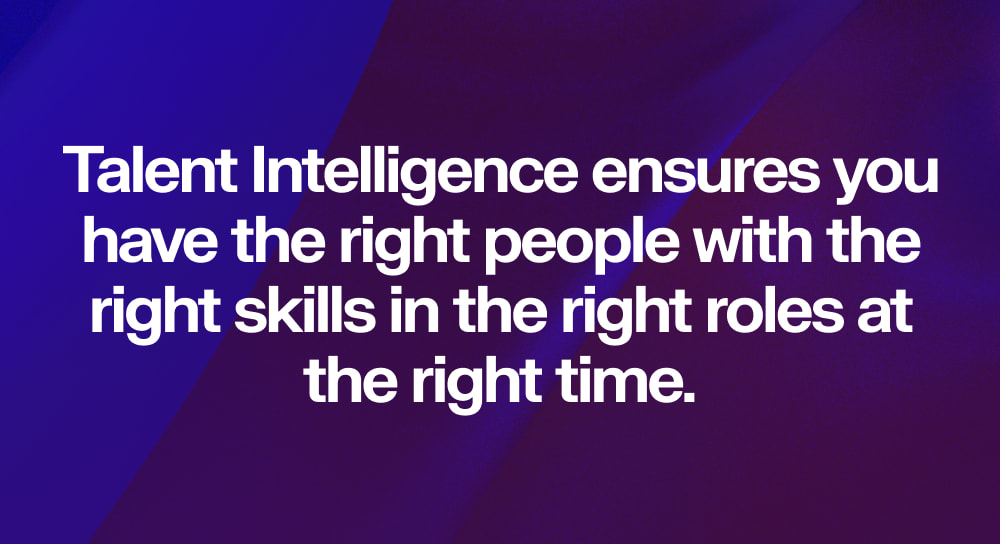Talent Intelligence Explained: Unlocking The Power of Data In HR
Talent intelligence refers to the process of gathering, analyzing, and applying data related to an organization’s workforce, in order to optimize your talent management strategies.
It involves taking data around the skills, experiences, and potential of current and prospective employees, and then connecting this to other information (about roles, the company, and the wider market) to help you make high quality decisions on recruitment, development, retention, and workforce planning. It ensures you have the right people with the right skills in the right roles.

Talent intelligence would tell you, for example, which markets to expand or move into, based on the availability and cost of appropriate labor in those geographies.
It could show you which functions within your business would benefit from upskilling investment, based on the new types of products planned for launch.
It could advise on the sourcing channels that were bringing in the most productive new members of staff, so you could double down on the strongest tactics.
Talent intelligence helps create more useful and impactful experiences for candidates, recruiters, employees, HR teams and managers – while linking workforce decisions to business outcomes. A talent intelligence platform is therefore essential for enterprise organizations hoping to transform or grow.
From Information to Intelligence 💡
Intelligence is not the same as information, or insights. A list of candidates (and a list of jobs) is information. From there, you could generate insights: which candidates would be a good fit for which role, for example, based on signals of potential and intent.
But true talent intelligence comes from understanding why the specific combination of skills, potential and intent makes for a good match… and that requires a system with a deeper “understanding” of each person, and each position.
Without data that’s standardized, complete, fresh, unique, valid, and usable… meaningful talent intelligence can’t be derived.
Gathering Information 🗂️
The starting point for any form of “intelligence” is data, and ideally a common data “language” or currency. You need a way of describing “talent” that can also be applied to job roles, job families and learning & development opportunities. Skills is the language that works best here.
So what does that “skills data” actually look like?
- A skills taxonomy that spells out what different skills ‘mean’ in your organization.
- A talent database where prospective candidates, as well as employees, are organized based on skills they possess.
- A job architecture that defines the skills needed for various types of role (even as they change).
- External insights about the supply and cost of various skills, in your industry and relevant markets.
- Hiring data (what skills did we acquire).
When you connect these elements, you build a holistic and dynamic picture of skills supply and demand. You also get a comprehensive understanding of a candidate’s journey, from the first point of contact, to hiring, to coming back as an alumni. And you create the ideal conditions for AI to do its job, and turn your information into intelligence.
You will only get high quality outputs if high quality inputs (i.e. trustworthy data) are helping power the algorithms. Accurate, rich and up-to-date information around skills is what AI needs, in order to deliver talent intelligence.
Generating Intelligence 🤓
Going from data to action – which is what Talent Intelligence is all about – relies on bringing your skills data into one place, and then applying (explainable, ethical) AI to uncover connections and reveal the best next step.

AI can turn data into insights across every stage of the talent lifecycle, revealing the trends and patterns that will help you make cost-effective plans to acquire the right skills. And it can give employees a powerful and equitable way to access development opportunities, showing them how they could advance through the organization.
The Power of Talent Intelligence 🚀
Relying on a unified foundation of enriched, clean, and standardized talent data, plus AI to derive insights and recommendations, a talent intelligence platform is essential for enterprise organizations hoping to transform or grow. With the right talent intelligence, you can:
- Understand talent: Get a clear and actionable view of your company’s current and adjacent skills, the skills in your wider talent pool, and the development potential of your workforce.
- Make better decisions: Identify how to “build, buy and borrow” your workforce of the future, and inform hiring, restructuring, upskilling and reskilling strategies.
- Build a single source of truth: Unify skills data from different sources, ontologies, and HCM systems into a single, universal taxonomy for a consistent and real-time view of what you have today, and what you’ll need in the future.
- Benchmark your workforce: Pinpoint internal skill gaps, and track global trends from live labor market data. See which skills are on the rise, and the market value of different jobs, so that you stay one step ahead – and avoid “talent risk”.
Talent intelligence brings together data analytics with human resource management to make it easier to attract, develop, and retain top talent, aligning your workforce capabilities with wider business goals. In a world where talent is scarce and skills gaps abound, it is surely an essential component of your strategy.